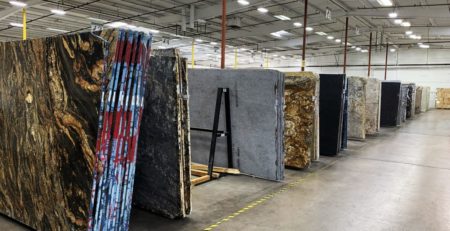Stain Removal
Spills and Stains
Blot the spill with a paper towel immediately. Don’t wipe the area, it will spread the spill. Flush the area with plain water and mild soap and rinse several times. Dry the area thoroughly with a soft cloth. Repeat as necessary. If the stain remains, refer to the section in this brochure on stain removal.
Stain Removal
Identifying the type of stain on the stone surface is the key to removing it. If you don’t know what caused the stain, play detective. Where is the stain located? Is it near a plant, a food service area, an area where cosmetics are used? What color is it? What is the shape or pattern? What goes on in the area around the stain? Surface stains can often be removed by cleaning with an appropriate cleaning product or household chemical. Deep-seated or stubborn stains may require using a poultice or calling in a professional. The following sections describe the types of stains that you may have to deal with and appropriate household chemicals to use and how to prepare and apply a poultice to remove the stain.
Types of Stains and First Step Cleaning Actions
OIL-BASED
(grease, tar, cooking oil, milk, cosmetics)
An oil-based stain will darken the stone and normally must be chemically dissolved so the source of the stain can be flushed or rinsed away. Clean gently with a soft, liquid cleanser with bleach OR household detergent OR ammonia OR mineral spirits OR acetone.
ORGANIC
(coffee, tea, fruit, tobacco, paper, food, urine, leaves, bark, bird droppings)
May cause a pinkish-brown stain and may disappear after the source of the stain has been removed. Outdoors, with the sources removed, normal sun and rain action will generally bleach out the stains. Indoors, clean with12% hydrogen peroxide (hair bleaching strength) and a few drops of ammonia.
METAL
(iron, rust, copper, bronze)
Iron or rust stains are orange to brown in color and follow the shape of the staining object such as nails, bolts, screws, cans, flower pots, metal furniture. Copper and bronze stains appear as green or muddy-brown and result from the action of moisture on nearby or embedded bronze, copper or brass items. Metal stains must be removed with a poultice.(See section on Making & Using a Poultice) Deep-seated, rusty stains are extremely difficult to remove and the stone may be permanently stained.
BIOLOGICAL
(algae, mildew, lichens, moss, fungi)
Clean with diluted (1/2 cup in a gallon of water) ammonia OR bleach OR hydrogen peroxide. DO NOT MIX BLEACH ANDAMMONIA! THIS COMBINATION CREATES A TOXIC AND LETHAL GAS!
INK
(magic marker, pen, ink)
Clean with bleach or hydrogen peroxide (light colored stone only!) or lacquer thinner or acetone (dark stones only!)
PAINT
Small amounts can be removed with lacquer thinner or scraped off carefully with a razorblade. Heavy paint coverage should be removed only with a commercial “heavy liquid” paint stripper available from hardware stores and paint centers. These strippers normally contain caustic soda or lye. Do not use acids or flame tools to strip paint from stone. Paint strippers can etch the surface of the stone; re-polishing may be necessary. Follow the manufacturer’s directions for use of these products, taking care to flush the area thoroughly with clean water. Protect yourself with rubber gloves and eye protection, and work in a well-ventilated area. Use only wood or plastic scrapers for removing the sludge and curdled paint. Normally, latex and acrylic paints will not cause staining. Oil-based paints, linseed oil, putty, caulks and sealants may cause oily stains. Refer to the section on oil-based stains.
WATER SPOTS AND RINGS
(surface accumulation of hard water)
Buff with dry 0000 steel wool.
FIRE AND SMOKE DAMAGE
Older stones and smoke or fire stained fireplaces may require a thorough cleaning to restore their original appearance. Commercially available “smoke removers” may save time and effort.
ETCH MARKS
Etch marks are caused by acids left on the surface of the stone. Some materials will etch the finish but not leave a stain. Others will both etch and stain. Once the stain has been removed, wet the surface with clear water and sprinkle on marble polishing powder, available from a hardware or lapidary store, or your local stone dealer. Rub the powder onto the stone with a damp cloth or by using a buffing pad with a low-speed power drill. Continue buffing until the etch mark disappears and the marble surface shines. Contact your stone dealer or call a professional stone restorer for refinishing or re-polishing etched areas that you cannot remove.
EFFLORESCENCE
Efflorescence is a white powder that may appear on the surface of the stone. It is caused by water carrying mineral salts from below the surface of the stone rising through the stone and evaporating. When the water evaporates, it leaves the powdery substance. If the installation is new, dust mop or vacuum the powder. You may have to do this several times as the stone dries out. Do not use water to remove the powder; it will only temporarily disappear. If the problem persists, contact your installer to help identify and remove the cause of the moisture.
SCRATCHES AND NICKS
Slight surface scratches may be buffed with dry 0000 steel wool. Deeper scratches and nicks in the surface of the stone should be repaired and re-polished by a professional.
Information provided by the Marble Institute of America





